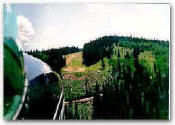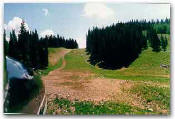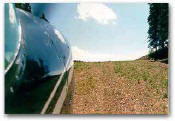Possum Creek 'ain't' such a much
By Sparky Imeson
As with many mountain strips, it is often more difficult, but totally necessary, to psyche oneself up for landing than it is to perform the task of touching down and stopping within the runway length. For example, place a 2-by-4 on the ground and ask any friend (or enemy) to walk along its length. Piece of cake. But, suspend the 2-by-4 some 30 feet above the ground. Now it is another matter, with the psychology involved making it difficult to scale its length.
Move Possum Creek airstrip to the prairies and a student pilot can safely and easily operate from its parameters. But, hide the same strip between two ridges with 700-foot cliffs at each end, add an incline, and consider the density altitude; it now becomes a strip requiring some self-administered psyche.
| For operating at Possum Creek, one had better know something about psychology or mountain flying, or both. An adrenaline rush doesn't quite explain the emotions surging through a pilot landing at 10,010-foot-high Possum Creek 'International' airport in northern Colorado. |
I corresponded by mail and talked on the telephone with Dave Force Jr. beginning in 1990, we tried to get together for a flight into Possum Creek. Scheduling conflicts, adverse weather and snow-covered terrain prevented it until 1994.
With anticipation and excitement, at least on my part, Force, my spouse and I departed the Glenwood Springs, Colo. airport in Force's Cessna 180 en route to Possum Creek. The first view of the strip gives one the idea, "This ain't such a much." And, from high above the ridge lines, the strip actually does have an innocuous look. But, reserve that judgment until descending to 9,840 feet, the elevation at the approach end. Next, perform a flyby to test for downdrafts. Now the area takes on an ominous aspect.
This 1,360-foot ribbon of grass-covered soil, embedded throughout with small rocks, serves as the landing area. Its orientation is east-west.
Some operators to a sloped airstrip use an excess-airspeed technique. This allows the pilot to change from the glide attitude to an attitude paralleling the slope, and then to make the change to the landing attitude. Without the excess airspeed at the beginning of the maneuver, the speed bleeds off during the round-out and the airplane experiences a high sink rate and the inability of the elevator to lift the nose. (The author thinks this type approach is best reserved for a forced landing without engine power to a landing on upslope terrain).
The excess-airspeed approach is not used at Possum Creek. About nine years ago, Force tried the technique and wound up with too much speed after touchdown. This caused some anxious moments and the heavy braking nearly caused a nose-over as Force tried, and finally succeeded, in preventing the airplane from dropping off the 700-foot cliff or flipping over on its back.
Because of the flat touchdown area, Force found a flat approach works best. This isn't to mean the airplane is operated on the back side of the power curve with the airplane hanging on the prop. A normal approach speed is maintained until the flare. Eliminating the descending approach does away with he need for excess airspeed.
Occasionally being described as a bull-headed mule, I was open for all suggestions for operating at this strip. Any self-respecting pilot would want to give it a try.
After a north-to-south pass by the west end of the runway, placing us in a position of advancing toward lowering terrain, we determined there were no downdrafts to spoil our morning. We continued with a right turn until lining up, a mile and a half out, on final.
| The air was stable and we had no trouble maintaining an altitude slightly above the touchdown spot. A normal flare resulted in a smooth landing. Using this technique, it was necessary to add power to make it to the top of the runway surface, where the airplane can be turned around for the takeoff, or parked. |
Takeoff requires no special technique. The 10-percent downslope exists for the first one third of the runway and changes to 20-percent downslope. A gentle application of power, until the airplane begins to move, protects the propeller from rock damage. At the end of the 10-percent downslope, before dropping to a steeper angle, Force grabbed the flap level and gently flew the airplane from the surface. A gradual left turn, while milking off flaps, provided an escape route where the terrain fell away rapidly.
Force began pointing out various emergency landing sites, should the engine decide to quit at an inopportune moment. In the couple of hours we had been together, I grew to like Force. But now, I realized how much I liked his piloting abilities, techniques and concern for safety. There was not the "let me show you how good I am" display that is sometimes encountered with this type operation. The flight was conducted in a totally professional manner.
Force doesn't want to have the location of Possum Creek divulged to the general public, feeling someone could get into trouble. Also, insurance requirements dictate this must remain a private airstrip. Force doesn't charge to fly his friends into his strip. I didn't ask if there is some way a person could fly in there with him, but he does own a transmission shop. If you find it necessary to land at Possum Creek, perhaps you could leave your car for some transmission work and try to convince Force to take a flight while waiting for the car. Who knows? It might be worth a try.
|
|
|




